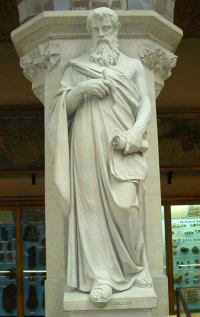History of Euclidean Geometry

Euclidean Geometry began in the heart of Alexandria around 300 BCE with a man called Euclid. Euclid was the author of the book, Elements of Geometry ,
which was a unified collection of mathematics. The Elements are broken down into three sections: Books I-IV and VI discuss plane geometry, Books V and VII-X deal with number theory, and Books XI-XIII work in the area of solid geometry. Many ideas in the
Elements were not his and had been proven in isolated situations by other mathematicians, but his greatness came from the ability to organize the vast independent information and facts into the Greek geometry and number theory of his time. Euclid was aware
of his need to avoid circularity and provide a starting point for these facts. He created what are called "axioms" or "postulates" that were to be viewed as self-evident truth and were the starting ground rules for proving theorems. He used all the geometry
amassed from the time of Thales into 5 postulates and five axioms from which he deduced 465 propositions, using each one as a stepping stone to the next. The only tools he used to help him with his theorems were a straight edge to draw lines and a compass to draw arcs.
Wow!
The five axioms Euclid defined are as follows:
- Things are equal to the same thing are also equal to one another.
- If equals are added to equals, the whole are equals.
- If equals are subtracted from equals, the remainders are equal.
- Things that coincide with one another are equal to one another.
- The whole is greater than the part.
The five postulates Euclid defined are as follows:
- A straight line can be drawn from any point to any other point.
- A finite straight line can be produced continuously in a line.
- A circle may be described with any center and distance.
- All right angles are equal to one another.
- If a straight line falling on two straight line makes the interior angles on the same side less than two right angles, then the two straight lines, if produced indefinitely, meet on that side which are the angles less than two right angles.
Postulate #5 was an interesting insight of Euclid's and no one is sure of where he came about this idea. He never proved that it held true and never referred to the postulate in any of proofs for his theorems until much later in the Elements when he had no other path to take in the proof.
It wasn't until many centuries later that the postulate was proven to be true.
Euclid's books were the main text used in classrooms for many centuries after it's creation. Even President Lincoln studied the first 6 books in his struggling lawyer day to build strong problem solving skills.
Other textbooks have moved in and taken over in the classroom, but we still spend time studying the amazing work of Euclid and continue to push the boundaries of Geometry with his knowledge.
